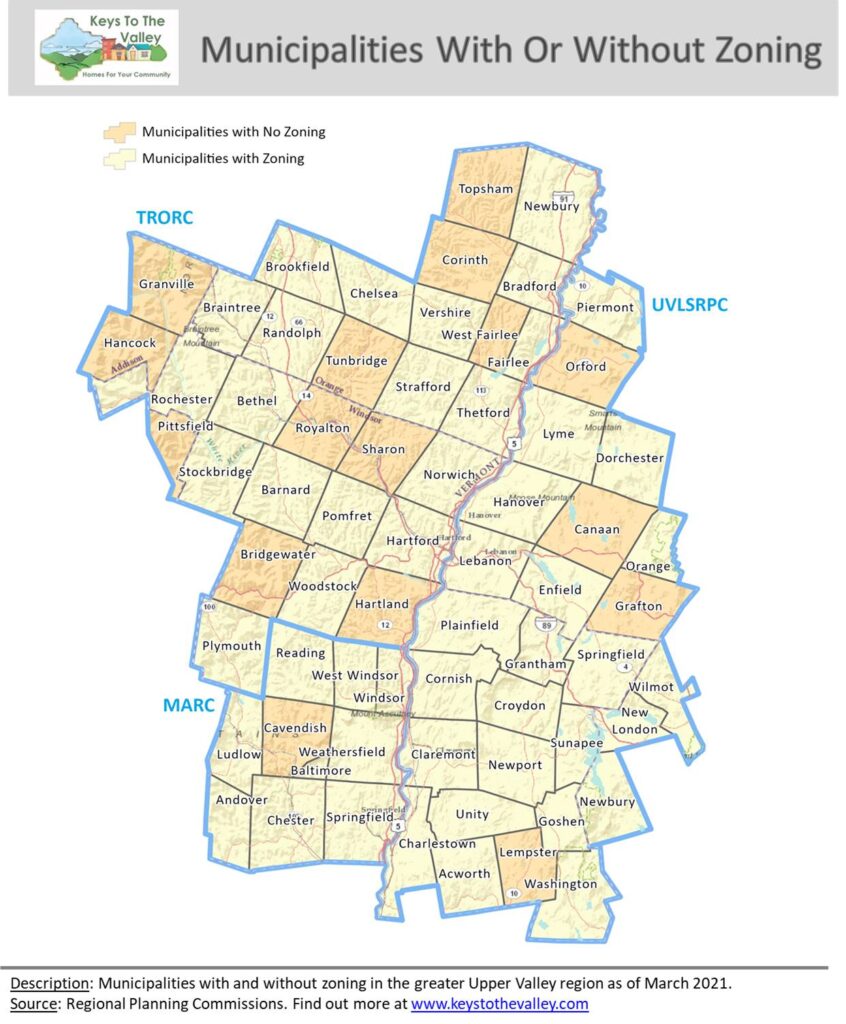Local land use regulations are often held up as a barrier to housing and a reason for increased housing costs (see Surveys callout). As a blanket statement, this is not always applicable, since many towns have no local land use regulations and still struggle with affordable housing costs. However, in specific cases it is true, as land use regulation standards and processes can create unnecessary costs and delays.
The term “land use regulations” in this document encompasses local zoning and subdivision permitting. In Vermont, zoning and subdivision regulations are referred to as ‘bylaws’ in statute, unless otherwise established as an ‘ordinance’ under a town charter. In New Hampshire, zoning is adopted as an ‘ordinance’ and subdivision and site plan review are ‘regulations.’
This paper identifies common land use regulation standards in both New Hampshire and Vermont that often have questionable benefit, and suggests simple fixes to replace these. Land use regulations are a tool meant to achieve orderly and beneficial development, and like any tool, there are well-made ones and poorly-made ones. Also, the way in which a tool is used may be more important than the quality of the tool, and therefore this section also reviews the way in which these regulations function during permit processes that can stretch out a project’s timeline, creating costs. The paper has been separated into five main sections:
Municipalities largely regulate the creation and use of lots through subdivision and zoning (see Additional Resources callout). Subdivision authorizes the creation of lots and associated facilities such as roads, and zoning permits the construction of homes or other development on the lots. New Hampshire and Vermont have different regulatory structures under the enabling statutes in each state. Northern New England has a tradition of strong state legislative oversight of municipal governments. As such, all powers of municipal governments are enabled by state law, as opposed to in “home rule” states where there are greater levels of local autonomy. In other words, local subdivision and zoning authority is limited to only what is ‘enabled’ by statutes in both states.
New Hampshire requires that every community provide ‘reasonable and realistic opportunities for the development of workforce housing (NH RSA 674:58-61). Vermont requires that any zoning (24 VSA Section 4412) must not have the ‘effect of excluding housing that meets the needs of the populations.’ Regulations should be revised, not only to meet the intent of these state requirements, but also to ensure that businesses have adequate home options for employees, residents are safely housed, and land and infrastructure are used efficiently.

As regulatory standards and processes are reviewed below, it is important to remember that most were put in place for a reason, and that lessening regulations can simply shift costs onto municipalities or neighbors (for example, developers may be required to construct roads or sidewalks, and removing that requirement may mean that residents later petition the town to build these). The goal of the suggestions below is to provide guidance on the simplest options to remove or alter regulations in a way that still meets the overarching goals of a community. These suggestions are grounded in current conditions and trends in the study area, and will need to be adapted to suit each community and modified as needs change, such as further demographic shifts and in/out migration.
Local land use approvals are only required if a town has adopted zoning or subdivision procedures, and also site plan review (SPR) in New Hampshire. In this part of Vermont, a majority of municipalities have adopted zoning, but some have neither of these and therefore no permit is needed under them (Figure 1). In New Hampshire, most municipalities have adopted subdivision regulations. For those municipalities in either state that have adopted land use regulations (e.g. zoning, subdivision), many of the regulations were written in the 1970s and are in need of modernization. Some of the common local regulatory issues specific to meeting a community’s housing need are summarized in this paper’s related sections.
Surveys Suggest Local Regulations an Important Factor for Housing
A number of surveys were conducted to inform the Keys to the Valley initiative, including public, municipal, and technical advisors. One of the survey questions asked about the top site factors that are most important in building affordably priced homes. The cost of land (65%) and existing infrastructure (65%) had the most responses, but regulations came in third (50%). Top regulatory factors identified were zoning (65%), objections from neighbors (50%), state permits (20%), and permitting process times (20%).
Municipal officials were also surveyed, with a total of 140 responses from 52 communities in the greater Upper Valley region, with relatively even splits between both states, and equally representing planning board/commission, municipal staff and other board members. When asked if the lack of affordable and accessible housing is primarily due to regulations, municipal officials were split, with a slight majority (52%) agreeing and 48% disagreeing with that statement. Results suggest a strong willingness by municipal officials to revise local regulations in order to make their community more attractive for housing development. This willingness was 74% overall, but much stronger in larger communities (91%).
Vermont’s Zoning for Great Neighborhoods project also conducted a survey. When asked about primary factors preventing those housing needs from being met, respondents identified the high cost of construction and land availability as the top factors, followed by people being resistant to change and then municipal land use regulations. Developers ranked municipal regulations as the second top factor, while municipal officials and planners ranked municipal regulations lower, below other factors.
Additional Resources on State Land Use Regulations and Enabling
New Hampshire
- 2021 Planning Board Handbook by NH Office of Strategic Initiatives
- Planning, Housing, and Zoning Resources by NH Office of Strategic Initiatives
- Housing Solutions in New Hampshire by NH Housing
Vermont

